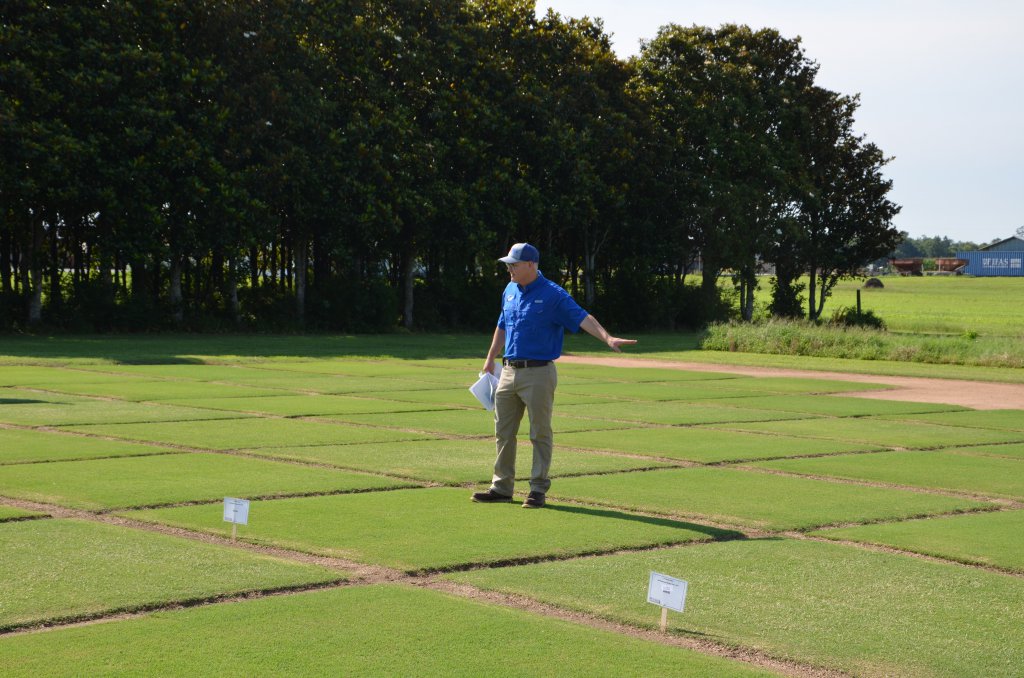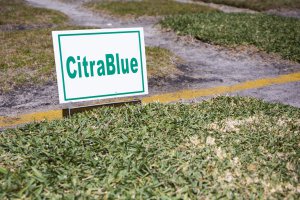Florida and Georgia, USA
October 29, 2021
When the University of Florida Gators take the field against the University of Georgia Bulldogs for their annual football rivalry on Saturday, the teams will be playing in neutral territory at TIAA Bank Field in Jacksonville, Florida. But the Dawgs may claim a little “home turf” at the stadium.
The Tifway 419 bermudagrass the teams will battle on for their 98th matchup was developed in the turfgrass breeding program at the UGA Tifton campus, widely recognized as one of the top turfgrass breeding programs in the world. The grass in UF’s Ben Hill Griffin Stadium — also known as “The Swamp” — is TifTuf, another UGA-Tifton variety.
And while the universities’ rivalry plays out on the football field, the turfgrass breeders behind the grass at UGA and UF work together to develop and test the varieties from each program, said Brian Schwartz, professor of turfgrass breeding at UGA and head of the university’s turfgrass breeding program.
Grass at home, grass away
Schwartz’s counterpart at UF, Kevin Kenworthy, professor of turfgrass breeding and genetics and interim chair of the UF/IFAS agronomy department, was also Schwartz’s advisor while he earned his doctorate at UF, graduating in 2008.
 Kevin Kenworthy at the 2021 Turfgrass Expo at the West Florida Research and Education Center. (UF/IFAS photo)
Kevin Kenworthy at the 2021 Turfgrass Expo at the West Florida Research and Education Center. (UF/IFAS photo)
Since 2010, Schwartz and Kenworthy have collaborated on a series of grants from the U.S. Department of Agriculture’s National Institute of Food and Agriculture (NIFA) Specialty Crop Research Initiative (SCRI) to develop drought-tolerant grasses, along with researchers at North Carolina State University, Oklahoma State University, Texas A&M University and University of California, Riverside.
“Each of our teams creates new hybrids and we send those to each other to plant in identical test plots,” said Schwartz. “We run all the same tests and have five to seven environments for testing to narrow down to the best varieties. It is common to have a handful of grasses that perform really well in one place, but as soon as they are planted out of their area of adaptation, they go downhill.”
Through this collaboration among universities across the country, the researchers are able to work together to quickly find out which perform best as local varieties and which will work as national varieties, Schwartz explained.
The future of turf
The success of the UGA turfgrass program is built on the legacy of retired UGA turfgrass breeder Wayne Hanna, who is well known for producing popular turfgrasses such as TifSport, TifEagle, TifGrand, TifBlair, and more recently, TifTuf. These grasses are used around the world, including at premier entertainment and sporting venues.
Kenworthy respects the accomplishments his former student has achieved at UGA.
“Brian Schwartz is the latest person in the lineage in that position, and he is a fantastic individual, both on a personal level and professional level. It can be difficult to go into a high-profile position, but he’s taken it his own direction and is collaborating more with other people and being very successful doing that,” Kenworthy said.
While Tifway and TifTuf are still the dominant varieties on the market from UGA, Kenworthy said he expects great things from Schwartz in the future.
“When you release these varieties, they need to have a time of success for the growers. The market and the growers can’t change varieties very quickly, so when you have a good variety, you need to let it run its course, but he’s got experimental lines on the shelf that he’s developed that we know are better because we’ve collaborated in the evaluation processes,” Kenworthy said of Schwartz. “Eventually, there will be even better products that will have been developed at Tifton and evaluated not only by UF, but also scientists at other universities. The future is bright.”
Collaboration for innovation
With only 150 miles between UGA-Tifton and the UF campus in Gainesville, Schwartz said the partnership between the universities is beneficial for many reasons.
“By having a good team of collaborators with similar expertise and who bring their own specialties, we are able to make gains much more quickly,” Schwartz said. “It’s always good to bounce ideas off people who are in the same discipline. In private industry, you would never talk to your competitors about how to do things better, but we are academics. We are not worried about sharing those things because we are land-grant institutions, we are all working toward our universities’ missions to improve things for the long run.”
Upon joining UGA in 2008, Schwartz admits that he initially brought his allegiance to his most recent alma mater with him — he purchased a Gators tag for his car that he kept for about five years. He now cheers on the Bulldogs.
“UGA is a great school, and I couldn’t imagine getting more support from the college, the crop and soil sciences department or the university,” Schwartz said of his academic home.

CitraBlue St. Augustinegrass sample at National Institute of Food and Agriculture (NIFA) in 2019. (UF/IFAS file photo)
No matter who wins the football game on Saturday, Kenworthy said he is content knowing a small secret about his “rival” turfgrass breeder and close friend.
“We have a lot of TifTuf growing here that we continue to evaluate. It’s a measuring stick in my own bermudagrass program, but we have CitraBlue, a St. Augustinegrass that was released from our program, and I know that Brian Schwartz’s home backyard is all CitraBlue. The Florida Gators may play on a turf developed in Georgia, but the UGA turf breeder’s kids play on grass bred at UF.”